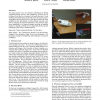ISMAR
2009
IEEE
14 years 6 months ago
2009
IEEE
ISMAR
2009
IEEE
14 years 6 months ago
2009
IEEE
This paper presents a new user interface methodology for Spatial Augmented Reality systems. The methodology is based on a set of physical tools that are overloaded with logical fu...
ISMAR
2009
IEEE
14 years 6 months ago
2009
IEEE
Unlike dense stereo, optical flow or multi-view stereo, templatebased tracking lacks benchmark datasets allowing a fair comparison between state-of-the-art algorithms. Until now,...
ISMAR
2009
IEEE
14 years 6 months ago
2009
IEEE
Augmented reality applications often rely on a detailed environment model to support features such as annotation and occlusion. Usually, such a model is constructed offline, whic...
ISMAR
2009
IEEE
14 years 6 months ago
2009
IEEE
We present a robust camera pose estimation approach for stereo images captured in untextured environments. Unlike most of existing registration algorithms which are point-based an...
ISMAR
2009
IEEE
14 years 6 months ago
2009
IEEE
It is extremely challenging to run controlled studies comparing multiple Augmented Reality (AR) systems. We use an “AR simulation” approach, in which a Virtual Reality (VR) sy...
ISMAR
2009
IEEE
14 years 6 months ago
2009
IEEE
Spatial tracking is one of the most challenging parts of Augmented Reality. Many AR applications rely on the fusion of several tracking systems in order to optimize the overall pe...
ISMAR
2009
IEEE
14 years 6 months ago
2009
IEEE
In many cases, visual tracking is based on detecting, describing, and then matching local features. A variety of algorithms for these steps have been proposed and used in tracking...
ISMAR
2009
IEEE
14 years 6 months ago
2009
IEEE
This paper proposes an approach to mixed environment training of manual tasks requiring concurrent use of psychomotor and cognitive skills. To train concurrent use of both skill s...
ISMAR
2009
IEEE
14 years 6 months ago
2009
IEEE
Visuo-haptic mixed reality consists of adding to a real scene the ability to see and touch virtual objects. It requires the use of seethrough display technology for visually mixin...

